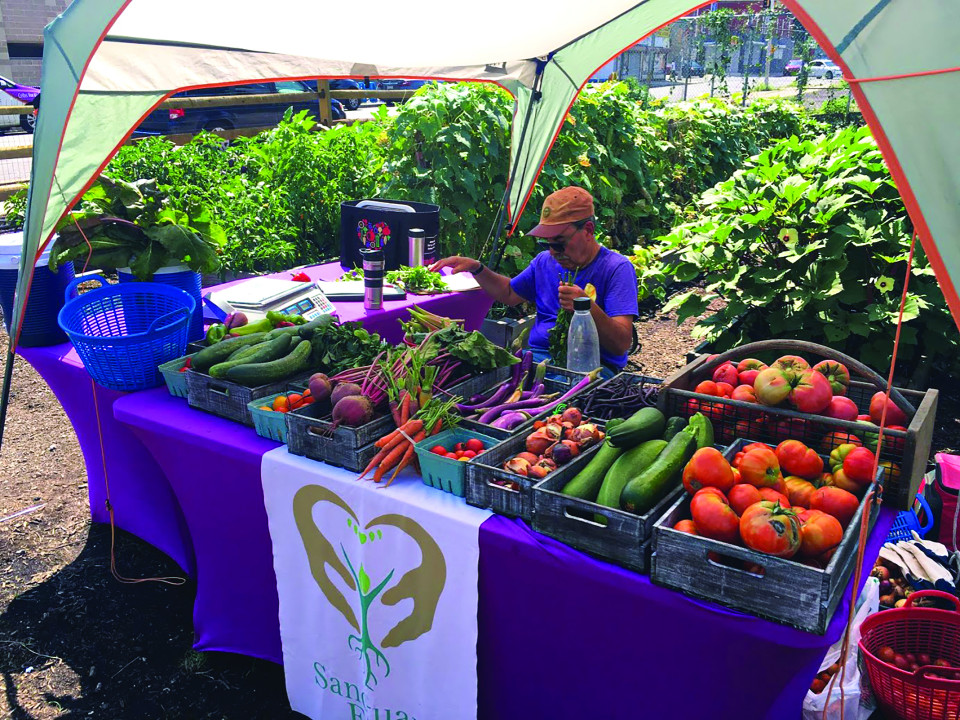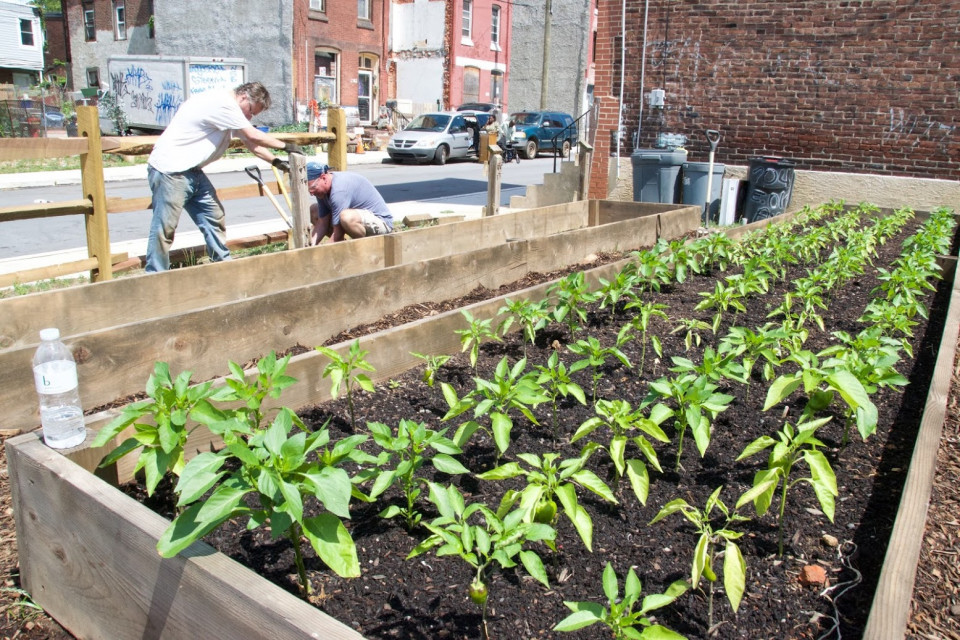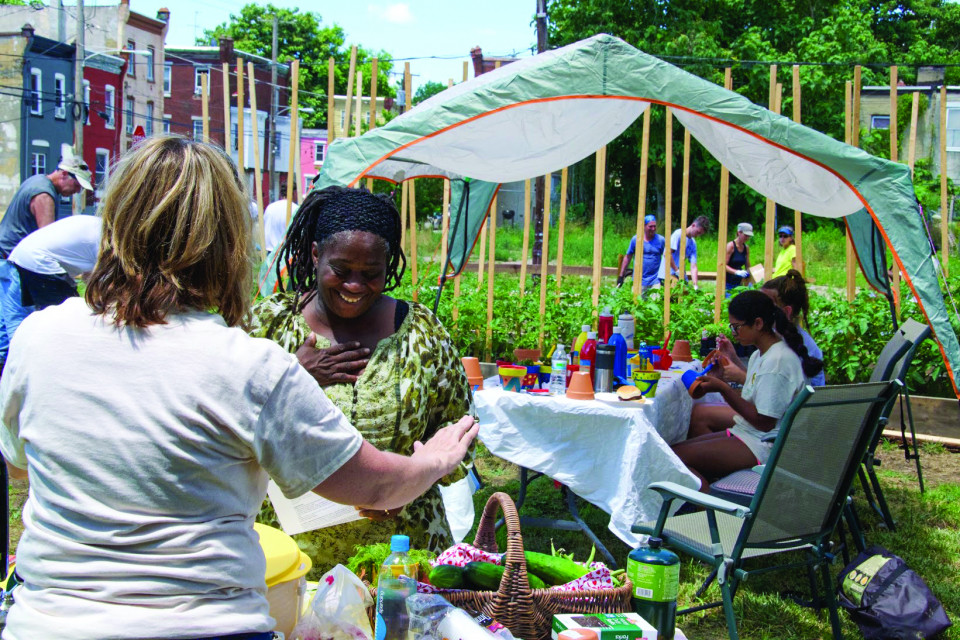Here’s Why That Community Garden in Your Neighborhood Might Actually Be Saving Lives

For nearly three decades, Andrea Vettori worked as a nurse practitioner, offering healthcare and social support to the homeless and unstably housed. But after years of effort, she became frustrated with what she felt was an inability to treat the causes of the problems she was seeing, leading her to start an urban farm in North Philadelphia.
“I feel like I can heal more people this way than I ever could writing prescriptions,” Vettori says. Dubbed Sanctuary Farm, the nonprofit provides free produce and nutrition education to the community.
“For almost 30 years I’d worked with communities living on the margins of society, treating people with illnesses that so often are related to lifestyle,” Vettori says. “It began to get so frustrating knowing that I was ask-ing people to eat right and control or prevent their chronic illnesses, knowing they didn’t have the resources to do that, knowing that they were going back to a food desert.”
By “food desert,” Vettori means an area where affordable, nutritious food is not within easy reach, often low-income neighborhoods that lack a grocery store and depend on corner stores and restaurants for sustenance. Vettori notes that residents of these areas often struggle with high rates of stress and mental illness due to factors like systemic racism, poverty and lack of a support system, making eating healthy all the more difficult.
These social factors create stark disparities in health outcomes: An average Society Hill resident can be projected to live as many as 20 years longer than an average North Philadelphia resident. The chief drivers of this difference in lifespan include diet-related conditions such as heart disease and obesity.
“We’re asking people to live healthy when they don’t know where their next dollar is going to come from, or they don’t know where they’re going to sleep tomorrow night, or they’re working three jobs to maintain rent,” Vettori says. “Learning a new, healthy lifestyle is not necessarily your top priority in that situation.”

In 2017, Vettori decided to tackle these issues directly when she received a grant from nonprofit Project HOME to create Sanctuary Farm. In three years, Vettori, a lifelong gardener, has expanded the farm to occupy four different lots in North Philly. In 2020, thanks to a grant from the American Heart Association, Sanctuary Farm provided fresh produce to about 125 people per week.
Finding Space to Grow
Urban farms like Vettori’s are becoming more critical, even as the land they’re built on becomes scarcer. One crucial reason for this is gentrification: Seven cities in the U.S. account for nearly half of the nation’s gentrification, and Philadelphia is ranked fifth among them.
Not only does gentrification drive lower-income residents into food deserts through rising rents—it can also drive up the leases on existing, lower-cost food markets. Higher-priced supermarkets take their place, and in the end, with a corner store on one side and a Whole Foods on the other, a low-income resident is left with few options that are both affordable and nutritious.
This economic divide also gets to the root of the challenge faced by Vettori. Many of the people who depend on her food struggle with issues of homeless-ness or housing security. At the same time, even abandoned lots can be too expensive for her to purchase for farm-ing, as speculators, anticipating rising prices, compete to buy them up years before gentrification begins. If she were to develop the land without purchase, as many farmers and gardeners do, she risks eventual displacement. Abandoned lots are often concentrated in the kind of developing areas that Vettori serves. If someone were to enable her, and people like her, to affordably develop that vacant land without the threat of removal, urban farms and gardens could serve their communities with a supply of cheap or free produce despite gentrification.
In the past few years, activists and policymakers in Philadelphia have started making headway in that approach. In 2012, zoning laws were changed to make community gardening and farming easier on vacant lots, and in 2016, the city surveyed land use and found that there were already 470 gardens citywide, many of which were started by Black residents, immigrants and refugees to be able to grow their own food, particularly culturally specific mainstays that can be hard to find.
In response, the city has formed an urban agriculture program within the Parks and Recreation department. According to Ash Richards, the director of urban agriculture for the city, they’re seeking to enable the creation of new community farms and gardens, as well as protect the existence of current ones, which are often under-recognized as critical food sources for communities.
“These gardens are being created because they need to be,” Richards says. “Many of these gardens have served their communities for years, if not generations. Over the years, because of neighborhood change, people are coming to us saying their gardens are threatened.” To start, Richards has opened up Philly’s parks for use in gardening, and offers support through increased access to water, seeds, compost, tools and training. While working on Philadelphia’s first urban agriculture plan, they’re examining the city’s handling of vacant land and hoping to increase protections among gardeners and farmers.
In the meantime, activist groups like the Public Interest Law Center in Philadelphia are pursuing legal avenues —from collective land ownership to litigation—to protect some of the most threatened farms and gardens from displacement.
“We do a lot of outreach to help people understand that community gardens are and should be seen as permanent features, not just temporary land uses,” says Ebony Griffin, staff attorney for the Public Interest Law Center. “The proposal we’re working on with the Pennsylvania state legislature in regards to green space and gardens would allow gardeners to gain ownership through the courts, if they have been taking care of the garden for at least 10 years. We’re in the early stages of the legislative process, but we are hopeful.”

A Community Effort
Sanctuary Farm shows how critical these sites can be to their neighborhood. It provides a lot more than produce; it’s a community center where the health of the whole neighborhood is impacted. Through the Philadelphia Housing Authority, Vettori is installing garden beds around public housing so she can teach residents to farm produce for themselves. She works with Project HOME to provide work and teach job skills to those struggling with homelessness. One employee, a veteran who fell into drug addiction after suffering from PTSD, has been promoted to a full-time role. The farm also provides produce to nonprofit, federally qualified health centers (FQHCs), so doctors can “prescribe” produce to patients.
Even everyday interactions make a big impact. In addition to stocking culturally appropriate foods for the neighborhood’s predominately Black community, the farm hosts cooking classes to introduce new foods. Neighborhood residents volunteer frequently at the farm, and Vettori says she has had countless individuals tell her about the positive health effects of eating farm-fresh produce for the first time in their lives.
“I think part of why people feel healthier and incorporate more produce into their diet through the farm, is that people are much more likely to take a bag of spinach home and eat it right away because they take such pride that the food came from their community,” Vettori says. “There’s a woman who swears she lost more weight than she ever has before by eating our vegetables, and she summed up our farm’s purpose really well. She said to me, ‘You’re not just feeding us. You’re healing us.’”
This is a paid partnership between Go Red For Women and Philadelphia Magazine